What Size Hook To Use For Trout Redfish And Snook
10 Best Redfish Baits & Lures Correct Now
A plethora of delicious entrees a redfish tin can't resist.
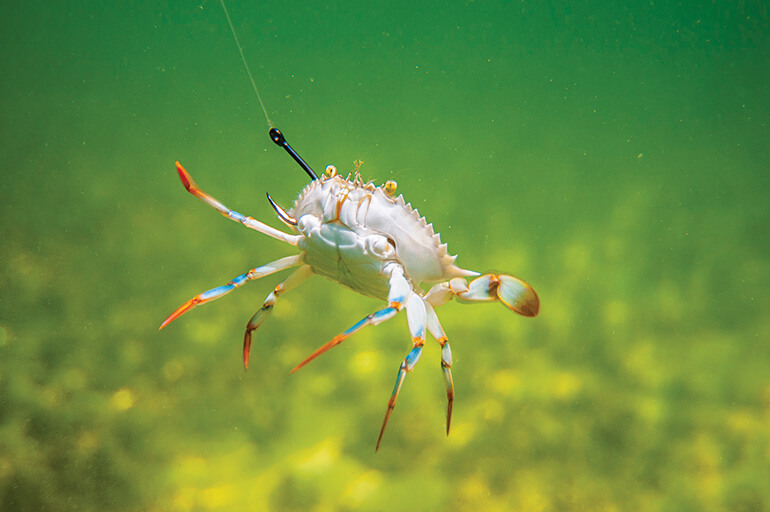
Live crab is a primo bait. It volition react, and the fish will react. But yous still have to make a expert bandage.
September 08, 2021
Perhaps the well-nigh accommodating of inshore gamefish, red drum tin can be caught in just whatsoever way imaginable in Florida. A red volition rise upwards and not and so gracefully smack a topwater plug in shallow water, and is just as happy to inhale a chunk of ladyfish rigged with an egg sinker on the bottom of a channel. And there are time-tested places where anglers armed with the top lures, flies and allurement tin bet on redfish success. And we are talking a varied menu. Maybe the question should be: What won't a redfish swallow?

Reds anywhere from "rat" to "balderdash" condition are encountered in Florida waters of all kinds. Grassflats, oyster bars, mangrove shorelines, inlets and passes, sandy beaches, under docks and bridges, y'all name information technology. You discover them where the nutrient is, basically. Though ideally congenital for bottom-feeding and grubbing, a reddish often takes prey such as baitfish, and swimming crabs and shrimp, in the center of the water cavalcade and fifty-fifty at the surface despite its underslung, inferior oral fissure.
There is no one best redfish allurement or lure. In that location are a bunch of bests! Merely hither are my Top Ten that get the job done just most anywhere you run into a ruddy.
1) Shrimp
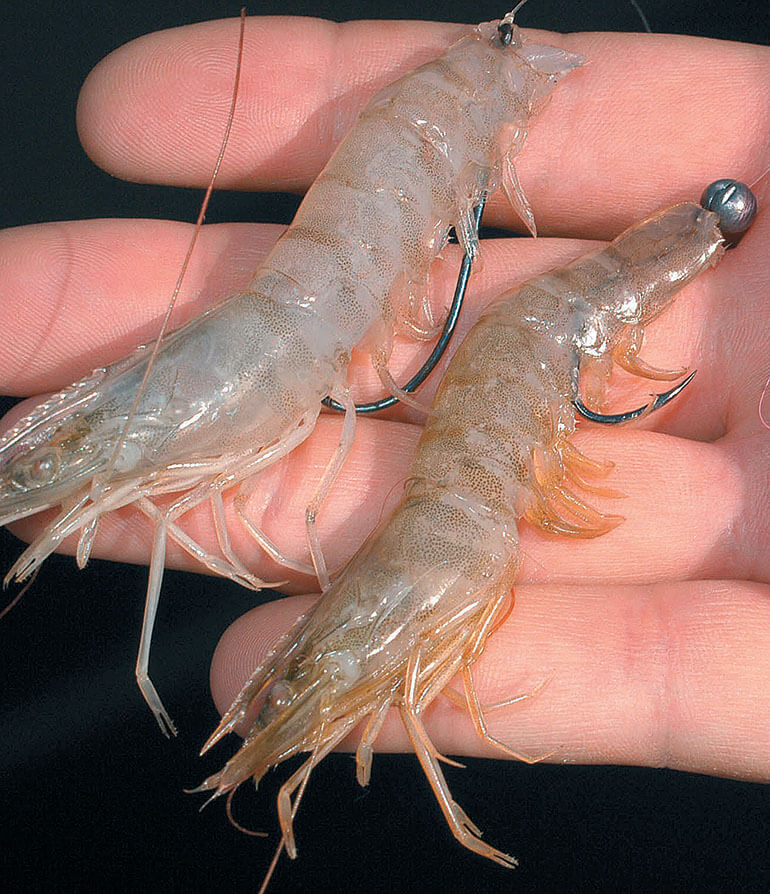
A live shrimp under a popping cork was central to my boyhood redfish indoctrination, and the place was Everglades City in the Ten Thousand Islands. Tossed nether a mangrove creek shoreline, redfish rally for shrimp, when not beaten to the punch by mangrove snapper and sheepshead. The latter two tin leave y'all with a blank hook. The hookup ratio is much amend with ravenous redfish, simply maybe you've discovered that already?
The shrimp can be hooked to stay live by passing the point and bend through the rear of its horn, merely information technology really matters picayune to a hungry redfish. A fresh-expressionless shrimp works just fine, threaded on the hook, or rigged Texas-style. The steady popular-pop-pop or the occasional Blurp! of the cork brings reds to the allurement, which is rarely turned downwardly. On one fine fall 24-hour interval I recall at least 3 reds clumsily and comically attacking my cork, without noticing the shrimp at all. And that is why I will cover topwater plugs in just a flake.
Fresh shrimp come in handy, too, wherever redfish become fussy on grassflats, or effectually shallow oyster confined. The scent does the trick, and the best vehicles include jig heads (or fully dressed jigs) and weedless spoons. A fresh shrimp either Texas-rigged or tail- hooked is deadly when sight casting to redfish in tailing depths.
2) Crab
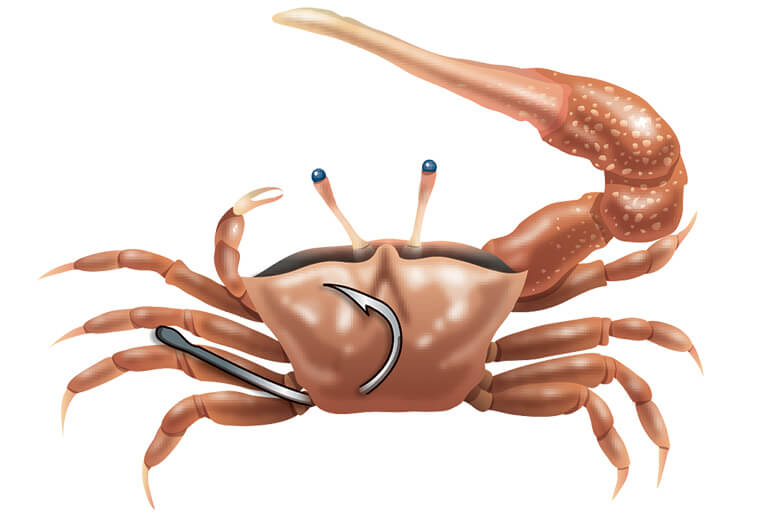
A hardy live bluish-hook crab is redfish processed in many places. Blue crabs are available at well-nigh littoral bait shops and cost around a dollar each. You can harvest them yourself, but check the recreational blueish crab harvest rules at www.myfwc.com.
Fiddler crabs are too a redfish delicacy, becoming an easy target when a high tide floods their marsh or shoreline habitat. In northeast Florida marsh country, fiddlers are a redfish staple, and fly tyers imitate them for good reason. High water levels caused past winds, a total moon, alluvion tides or combinations of all these let redfish to feed on the excellent stock of fiddler crabs. Fiddlers crabs can be fished with a light egg sinker, splitshots or on a 1/iv-ounce leadhead jig, with the claw passing through the bottom and right out the top of the vanquish. Don't overwork the jig—a deadening, lesser-kissing retrieve is best, and you will prevent line twist that tin can happen with all crab baits.
A whole blue crab with a iv- to five-inch carapace is terrific for bull reds over 30 pounds or so. Set the crab by removing the hard crush and the claws. Tip: Don't tear the claws off. Rather, employ force per unit area with your pliers at the "elbow" of the claw. Increase the pressure and the crab will sometimes "release" the claw. It'southward a trick I learned when I alive-baited for tarpon nether Florida Keys bridges at nighttime, and the crab volition alive longer on the hook and not twist the line in current. Many anglers prefer circumvolve hooks to J hooks for venereal. When a redfish takes the crab, it moves it to the rear of the throat and crushes it. Smaller slot-sized flats reds love a crab, too, and it can be the ticket to hookups when targeting hard-fished reds that take seen it all! The smallest "bonefish" crabs are bully—bandage them on a small heavy wire hook without weight in under 2 feet of h2o, and perhaps add a splitshot or two where deeper. The bait should be less than 3 inches beyond, and if sight fishing, lead the fish by most iii feet and go the allurement in its path.
3) Weedless Spoon
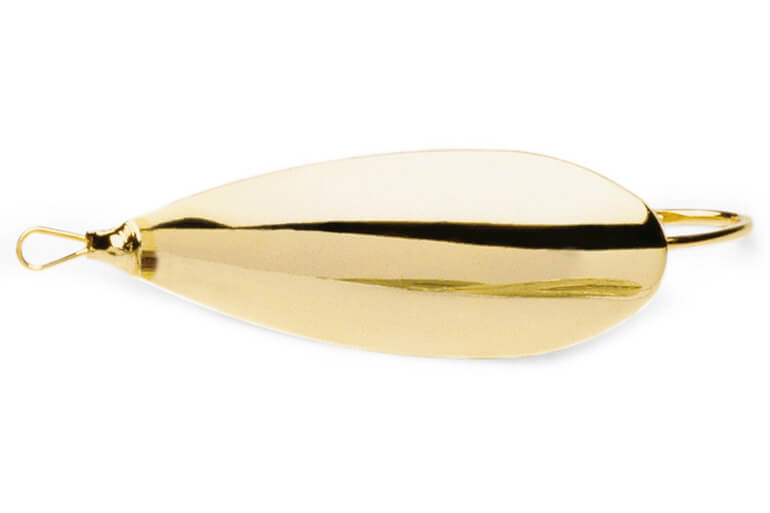
This archetype spoon has probably taken more than shallow-h2o reds than any lure. Narrowing information technology down, a gold spoon, any the brand, has long been the go-to choice. It has fallen out of favor a bit, and there may be some truth to the conventionalities that they "don't work" every bit well anymore due to conditioning of redfish where fished particularly hard. I can't argue it'southward possible, and in fact, years agone in Florida Bay, reds seemed to flare off when they saw it, so I switched to a black Johnson "Silver" Minnow. The switch worked for me on articulate sunny days, peradventure because black isn't as flashy in clear water. I would besides scuff the shine of my gold spoons with sandpaper to dull them. I was convinced information technology'south the wobbling activity and sound of the lure slithering through the grass that triggered the strike, non so much the smoothen.
At that place is quite an array of spoons now in comparison to when I fished the Johnsons in Florida Bay. But I still prefer the Johnson, with its wire weedguard for grassflat presentations. I prefer the 1/8-ounce size to larger sizes. The modest size casts a mile, doesn't get blown off course as much in a side current of air and the splashdown is lighter. You tin can tip the spoon with a brusk plastic tail if you similar for increased contour, and even a thumbnail-sized dab of fresh shrimp when the fish need some "coaxing." Information technology won't hurt the action of the spoon that much. Do employ a quality snap swivel to foreclose line twist. The Silverish Minnow wobbles without full revolution when retrieved slowly; information technology'south when you crank it in a warp speed to recast that information technology can twist your line.
4) Skimmer Jig

The number one lure in my stance basically due to its versatility. Whether y'all are line-fishing in a human foot of water for tailing reds, or peppering deeper flats potholes, or combing a shallow, mangrove-lined shoreline, a skimmer jig is tough to beat. The redfish may take information technology for a shrimp, crab or baitfish, who knows? I say crab. My favorite of all times is a 1/four-ounce Gaines Jerk Jig, and now utilize the 3/5- and ane/viii-ounce Backbone Lure. I fish this jig pure for flats reds, only may tip information technology when the fish are fussy, and when cold or hot water makes them lethargic. Other than sight fishing, search-line-fishing in slightly deeper water can exist washed with those in the 1/4-ounce size. Color-wise, yous can go "World tones" such as brown or tan to blend in over "salt-and-pepper" flats, or do an about-confront and necktie on a chartreuse/brown combo or something gaudier, such as hot pink/white or orange/brownish. In muddied h2o, a black jig stands out. They all work, you but have to experiment. And a monofilament weedguard (which comes standard on Backbone Lures) help keep loose grass off the claw. A loop knot gives this lure freedom of movement.
v) Soft-Plastic Jig

Today I would venture that 90 percent of redfishers adopt plastic-tail or scented tail jigs over those dressed with bucktail or other fibers. I fish the D.O.A. CAL quite a bit, and adopt both the shad-tail and curly tail versions. Both tails are terrific, activeness-wise, and give off vibrations that help redfish find the nutrient in night or cloudy waters. The soft bodies probably cause the fish to hold them a bit longer in their oral cavity before you lot set the hook, also. The main convenience is yous can switch out a tail color in seconds, other than a pilus jig. The soft tail can be pierced to allow for insertion of a small rattle sleeping room. The trick is to match the atomic number 82 head and claw length to the length of the tail. Be sure the gap between the hookpoint and torso is broad enough to facilitate hookups.
I reserve these one/4- and 3/five-ounce jigs for slightly deeper flats and channel edges, and piece of work them along bottom with the current. Ever tie this jig on your line or leader with a loop knot. The Berkley Gulp! scented tails add a strong attraction, highly-seasoned to the redfish'south senses of smell and taste.
6) Soft Plastic Swimbait
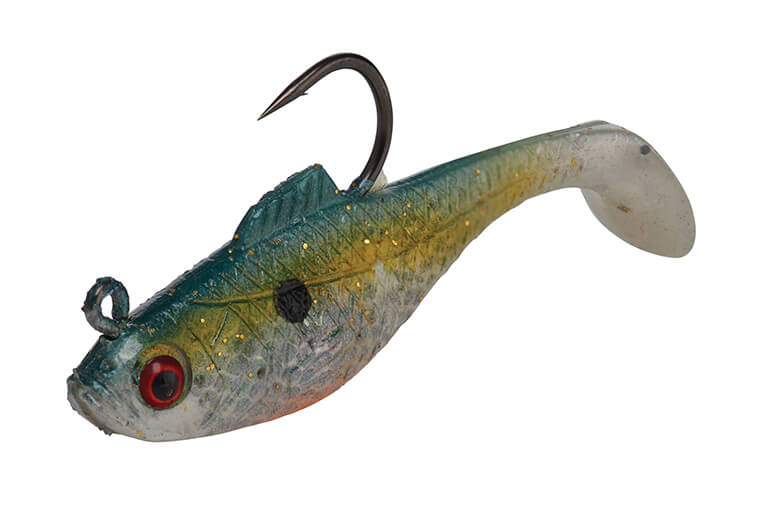
This category of soft plastics is more popular now than always, and information technology covers finfish, shrimp and crabs—the unabridged redfish nutrient grouping. Swimbait mainly refers to those lifelike mullet/whitebait imitations fitted with a weighted hook. I have had success on pass and mangrove backcountry redfish with the Storm Wildeye Swim Shad, and the same type of swimbait is a great choice for catching an inshore slam. The smallest versions are light enough for flats work, the bigger ones better suited to deeper water. These ride claw-upwards in the water making them ideal for lesser-bumping around oyster confined or flats potholes, and near have tails designed to vibrate on a direct retrieve. As the category suggests, these swim on their own without much added manipulation from the angler.
seven) Soft Plastic Jerkbait
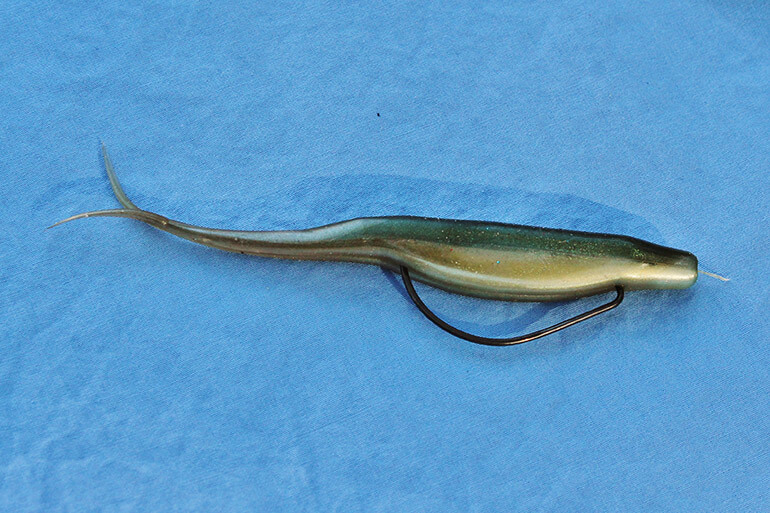
How many thousands of these beautify tackle shop walls now? I am referring to the soft type, not the hard body jerkbait. The basic shape, the fluke, is as proficient equally any. It has a tapered baitfish shape, 2-pronged tail that helps it swim level in the h2o, and even sprint in and out of the h2o with quick twitches of the wrist on the retrieve. The Zoom v-inch Super Fluke for example, is one I accept fished a lot for reds on stingrays, staging in potholes of the flats, and tailing in the shallowest water. Like most soft jerkbaits, this bait has a recessed pocket for reverse claw rigging, where you but skin the surface of the bait where the hook exits at the rear. This bait casts well for its weight, though you lot can add together a split shot or two on your line correct at the hookeye to make information technology sink faster if desired. The all-time thing is you can twitch this lure at the surface for topwater strikes, or allow information technology settle as deep as you need to reach the level of the fish. You can even use both methods on the same cast. Many anglers like the New Penny color though in that location is an array to cull from. Lengths of 3 to 5 inches are ideal for redfish.
8) Plastic Shrimp
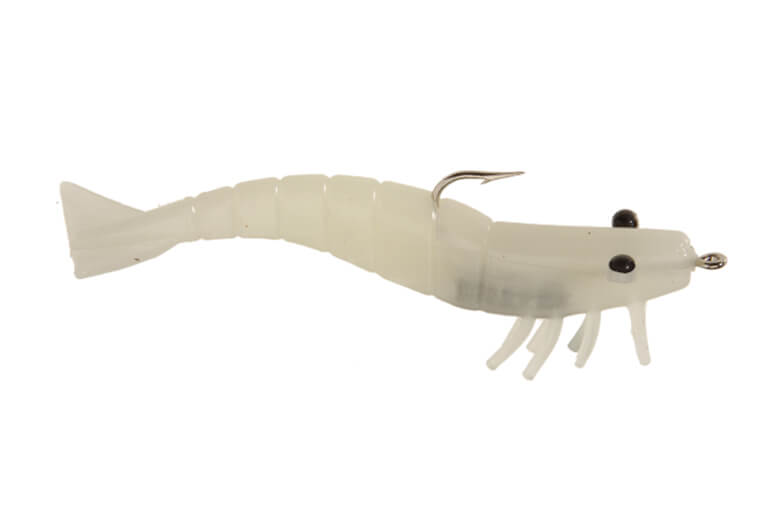
A slap-up search allurement, or for sight casting to redfish in clear water. In that location are easily x or more manufacturers of this lure, but I accept ever come back to the 1/4-ounce D.O.A. Shrimp for a couple of reasons. One, it has a unmarried hook. Two, the atomic number 82 weight is embedded, where information technology won't snag grass. It skips on the surface well with a sidearm delivery—which I use to catch redfish under docks on the Indian River Lagoon. There are a few more than realistic-looking products, but this 1 swims, and sinks, like a alive shrimp. For clear water, try the clear/red glitter or gold glitter version; a Figi Chicken or Rootbeer/Chartreuse tail where the water is stained or muddy. For searching out reds over deeper grassflats or nether docks, recall information technology with a dull swim and then employ a sharp wrist snap to brand it sprint before allowing it to sink on a tight line. Repeat. The strike often comes as information technology sinks.
9) Topwater Lure
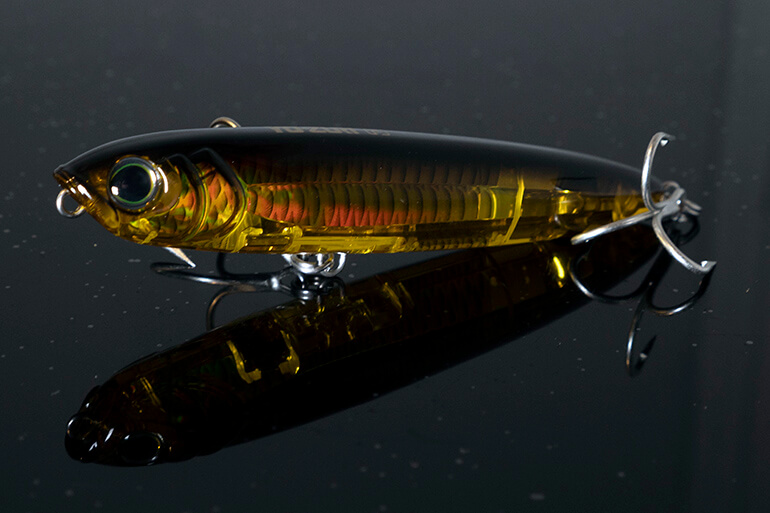
Though overlooked by many redfishers, topwater lures can bring out the aggressiveness in otherwise lethargic reds. And who can argue the thrill watching a sizable red lit up at the surface making repeated slashes before latching on?
If I had to narrow down the near constructive of them, I vote for the floater/diver. My onetime favorite for flats reds is the venerable Creek Chub Darter, a deadly snook plug equally well. The beauty of the Darter, and similar floater-divers, is that you can swim it just under the surface between rests on top. Redfish, with that junior oral fissure (under the head) are a bit clumsy when rotating their bodies to engulf something floating. But they readily make their move when this lure is on the swim. And there are dozens of other choices on the marketplace if the Darters are hard to find. To facilitate a quick release of redfish, consider mashing down the barbs on those treble hooks, or switch them out for single hooks that are like in weight to the trebles, and then that the lure's activeness isn't affected.
ten) Flies
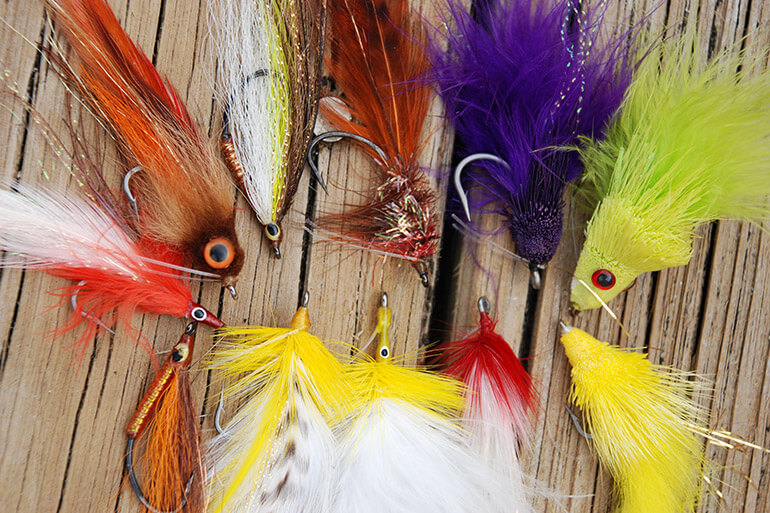
I can't proper noun a single favorite wing for reds. I take tied and fished "many dozens" of proven patterns that have reds. How about I requite you two—a crab and a shrimp/baitfish imposter?
When I'm stalking tailing redfish on the grassflats, I make a quick assessment on what the fish are doing. Tailers that are engrossed in their feeding have commonly establish the female parent lode, and that is ofttimes small crabs. Stomach checks of the rare fish that I killed over the years oftentimes confirmed that. Though I have tied many effective crab patterns, I actually like the Borski Critter Crab, which has also taken quite a few bonefish for me. Information technology's a elementary necktie, with prominent mono stem eyes. At that place are no elaborate legs, information technology is non realistic. It is an impressionistic crab. Small atomic number 82 dumbbell eyes or bead chain is used for weight. A two-prong mono weedguard fends off the grass. The body is either yarn tied in laterally and clipped, or wool can exist used. I necktie it on either a No. 2 or 1 claw, though go to a No. 4 for skinny, skinny h2o.
One of the oldest patterns in the saltwater book is the Homer Rhodes Streamer, later popularized by Chico Fernandez as the Ocean-Ducer. Information technology has been a become-to for me for xl years for redfish in shallow h2o. In "shrimpy" colors, it'due south a great impressionistic shrimp. Necktie i in white with a ruby-red head, it's a finger mullet. Information technology is 100 percent saddle hackle—the tail is comprised of six or so 3- to 6-inch matching hackles, some flash tin be tied in, and then you lot palmer (wind) a couple of hackles effectually the hook shank to from the caput. The palmered hackle append the wing, making information technology a terrific choice for grassy, shallow water. I love to cast it in tight to a busy tailer, permit it settle near it and then give it a twitch once the fish looks back up. It rarely fails. To imitate baitfish , I like a reddish/white color combination. I necktie this one with Cree hackle feathers and a little copper flash in the wing to imitate a shrimp. A mono weedguard is optional, and hook sizes range from No 2 to two/0.
What Size Hook To Use For Trout Redfish And Snook,
Source: https://www.floridasportsman.com/editorial/10-best-redfish-baits-lures-right-now/400747
Posted by: campbellhavot1998.blogspot.com


0 Response to "What Size Hook To Use For Trout Redfish And Snook"
Post a Comment